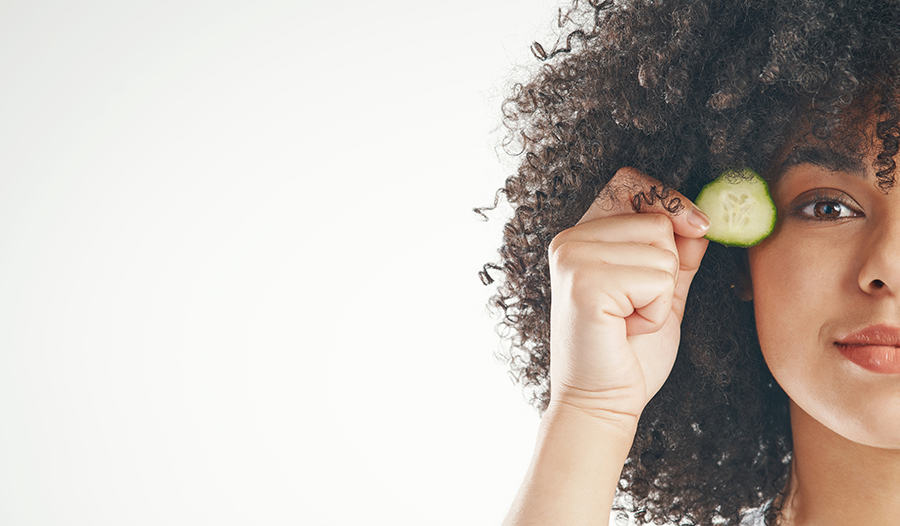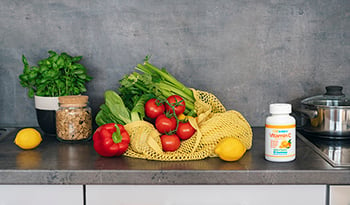The Best 10 Foods for Glowing, Healthy Skin
DISCLAIMER:This blog does not intend to provide diagnosis...
- In this article:
- Nutrition Tips for Healthy, Glowing Skin
- Supply a Rich Source of Essential Vitamins and Minerals
- Get the Right Types of Oils in the Diet
- Boost Collagen Production
- Protect the Skin from Oxidative Damage
- The Best 10 Foods for Glowing, Healthy Skin

There is a reason why glowing, healthy skin has long been associated with good health. What you see on the outside reflects what is happening inside. And nutrition plays a significant role in the health of the skin.
The skin is the body's largest organ and accounts for about 7% of your body weight, about nine pounds for most people. The skin is composed of several layers. The outermost portion is the epidermis (derm- means skin), serving as the body's central protective shield. Below that is the dermis, a thicker layer that provides support and nourishes the development of new skin cells.
Skin cells are born in the deepest of its four layers and migrate upward. By the time they reach the surface, they are no longer living. Each day you shed millions of these dead cells through washing or abrasion. You grow an utterly new epidermis every five to seven weeks.
The dermis consists of miles of nerve fibers, blood vessels, lymphatic vessels, and millions of oil glands and sweat glands.
Most of the dermis consists of flexible connective tissue that forms a matrix that holds everything together and allows skin to stretch and return to its original shape. Structural proteins, especially collagen (discussed below), as well as elastic fibers called elastin, and sulfur, are all critical to the health and function of this matrix. Collagen and related structures comprise roughly 75% of skin's dry weight.
Nutrition Tips for Healthy, Glowing Skin
The best strategy for supporting the skin's health is providing high-quality nutrition. Prioritize these nutritional goals for achieving beauty from within:
- Supply a rich source of essential vitamins and minerals.
- Get the right types of oils in the diet.
- Boost collagen production.
- Protect the skin from oxidative damage.
Supply a Rich Source of Essential Vitamins and Minerals
Each day, you shed millions of skin cells, and as you slough them off, new cells rise to take their place. A deficiency of any essential nutrient, whether it is a vitamin, mineral, fatty acid, or protein, can impair the manufacture of healthy new skin cells. In addition to eating a nutrient-rich diet, taking a multiple vitamin and mineral formula that provides at least the Recommended Dietary Allowance is a good "insurance policy" that these micronutrients are being provided in adequate amounts.
Get the Right Types of Oils in the Diet
Eating suitable types of fats is essential to glowing, healthy skin. The top 3 healthy fats to incorporate into your diet are monounsaturated fats, essential fatty acids, and long-chain omega-3 fatty acids.
Monounsaturated fats are heart-healthy fats in olive oil, avocados, nuts, and seeds. Eating one tablespoon of olive or avocado oil, or eating ¼ cup of raw nuts and seeds daily are easy steps to increase the intake of monounsaturated fats. Of course, these foods supply other beneficial nutrients for skin health.
There are only two essential fatty acids: linoleic (an omega-6 fat) and alpha-linolenic acid (an omega-3 fat). These fatty acids are considered essential nutrients because the body cannot manufacture them, so they must be ingested. One of the hallmark features of EFA deficiency is dry skin, cracked nails, dry lifeless hair, and dry mucous membranes.
Nuts and seeds are the best sources of linoleic acid (LA) and alpha-linolenic acid (ALA). But since omega-6 fat intake is generally high and omega-3 fatty acid intake tends to be insufficient in most diets, the focus should be on foods high in ALA and low in LA, such as flaxseed oil, flaxseeds, and chia. Other nuts and seeds that provide good levels of ALA are pumpkin seeds and walnuts.
Although it is possible to convert ALA from flaxseed oil, walnuts, chia, and other foods to the longer chain omega-3s EPA and DHA, it is not efficient. Including preformed EPA and DHA from fish like salmon, mackerel, and sardines, or by taking fish oil or algal-based supplements is important to provide adequate intake of the longer-chain omega-3 fatty acids. These fats help reduce inflammation that can make the skin look irritated. To ensure an optimal level of long-chain omega-3s, eat 2-3 servings of oily fish weekly and take a high-quality fish oil supplement. Use products that provide at least 60% omega-3 fatty acids and take a dosage that will provide a minimum of 800 to 1,000 mg of EPA+DHA as that level ensures adequate intake.
Boost Collagen Production
Collagen and supplements that impact collagen production are growing in popularity for supporting skin health. A lot happens in the collagen-rich support structure of the skin (i.e., the dermis) as we age. First and foremost, the activity of the fibroblasts, the cells responsible for making collagen, elastin, and hyaluronic acid, slows down. As we age, the dermis is less able to protect itself from damage and more prone to dehydration. These factors ultimately lead to a thinner dermis and structural changes that lead to skin looking old, wrinkled, and weathered.
Collagen dietary supplements are derived from various sources, including the skin, bones, and connective tissues of cows, chickens, pigs, and fish. When denatured by heat, collagen forms gelatin, used for centuries as a food source and traditional medicine. So, in other words, gelatin, as well as bone broth, is a source of collagen peptides. Gelatin and collagen supplements have been shown to help maintain skin elasticity and hydration, which may help minimize the appearance of skin aging.
Plant flavonoids are also critical in supporting healthy collagen. Especially beneficial are the blue or purple pigments—the anthocyanidins and PCOs (short for proanthocyanidin oligomers)—found in grapes, blueberries, red kidney beans, and many other foods. These flavonoids can also be found in pine bark and grape seed extracts. Flavonoids affect collagen metabolism in many ways:
- They have the unique ability to crosslink collagen fibers, reinforcing the natural cross-linking of collagen that forms the so-called collagen matrix of connective tissue (ground substance, cartilage, tendon, etc.).
- They inhibit the destruction of collagen structures by enzymes secreted by our own white blood cells during inflammation.
- They prevent the release and synthesis of compounds that promote collagen destruction.
To ensure sufficient levels of the most beneficial flavonoids, increase your intake of richly colored berries and other fruit, utilize raw cacao or cocoa powder, drink green tea, and eat red kidney beans. It is also a good idea to supplement your diet with a PCO extract like grape seed or pine bark at a dosage of 100 to 200 mg daily.
Protect the Skin from Oxidative Damage
Boosting dietary antioxidant intake by eating plenty of richly colored fruit and vegetables is a key goal in supporting skin health. It is important not only for making the skin look healthier and have fewer wrinkles but also for fighting skin disease. In addition to eating foods rich in antioxidants, you may want to consider supplementing with astaxanthin, the "King of Carotenoids." Astaxanthin supplementation positively affects skin health and appearance. It can accumulate in the skin and, as a result, improve all four layers of the skin. In one study, 49 middle-aged women were divided into two groups and took either 4 mg of astaxanthin daily or a placebo for six weeks. Positive results with astaxanthin supplementation were found across the various test methods:
- In the self-assessment (questionnaire), over 50% of the subjects taking astaxanthin rated improvements in all areas.
- Dermatologist assessment found improvements in all areas tested: Fine lines and wrinkles, elasticity, and dryness.
- Clinical instruments used in measuring skin moisture and elasticity recorded improvements.
- Before and after photos showed visible fine lines, wrinkles, and elasticity improvements.
The Best 10 Foods for Glowing, Healthy Skin
1. Berries, Cocoa, and Other Flavonoid-rich Foods
Berries, cacao powder, and other flavonoid-rich foods such as green tea, pomegranate, and citrus fruit exert several beneficial effects on the skin, such as the collagen-boosting effects noted above. Flavonoids also help improve blood flow and reduce inflammation.
Along with improvements in blood flow to the skin, in studies in women older than 40, those consuming a cocoa beverage containing 320 mg of flavonoids for 12 to 24 weeks also demonstrated significantly improved measures of skin elasticity, skin roughness, wrinkle depth, and moisture content. Similar benefits have been seen with other flavonoid-rich extracts.
2. Carotenoid-rich Fruits and Vegetables
Foods rich in carotenoids such as mangos, carrots, squash, sweet potatoes, and tomatoes provide antioxidants that help protect the skin from damage, especially sun damage. Try to get two servings daily (1 cup raw, ½ cup cooked equal a serving).
3. Collagen Peptides, Bone Broth, and Gelatin
Collagen peptides, bone broth, and gelatin provide the building blocks for connective tissue components that support the structure and health of the epidermis (skin).
4. Cucumbers
Fresh cucumbers are composed primarily of water, but their hardness is an excellent source of silica. Silica contributes to the strength of connective tissue, which holds the body together. The dermis is especially rich in collagen and other connective tissue. Without silica, the skin may lose the integrity of the connective tissue that supports and nourishes skin health. Cucumbers are often recommended as a source of silica and as a way to improve the skin's complexion and health.
5. Flaxseeds and Flaxseed Oil
Ground flaxseed and flaxseed oil are excellent sources of monounsaturated fat and essential fatty acids, linoleic acid and alpha-linolenic acid. A deficiency of essential fatty acids can lead to dry skin and other skin issues. Ground flaxseeds also provide a lot of dietary fiber and compounds known as lignans. Ground flaxseeds and/or lignans have been shown to promote cardiovascular health and protection against breast and prostate disease.
6. Green Leafy Vegetables
Kale, spinach, mustard greens, arugula, romaine lettuce, and other green leafy vegetables boost antioxidant status as well as provide many nutrients beneficial to skin health, including B vitamins, minerals, and phytochemicals like flavonoids and carotenoids.
7. Legumes (Beans, Peas, and Lentils)
Legumes are nutrient-rich foods that can also provide antioxidant benefits. One cup of black beans or red kidney beans is richer in antioxidant activity than a cup of blueberries. Legumes also provide protein, zinc, and other key nutrients for skin health. They also offer ceramides. These compounds are specialized fats that are important in regulating skin water content. Ceramides are also often used in topical preparations. However, oral ceramide intake has also been shown to lock in moisture within the skin, making it appear healthier.
8. Nuts and Seeds
Nuts and seeds are nutrient-dense foods that provide many key nutrients for skin health, including zinc and other minerals, protein, vitamin E, and healthy fats. They also can boost the body's levels of antioxidant compounds like glutathione. Rather than focus on any single nut or seed, it is best to eat a variety, as nuts have different nutritional profiles and health benefits. For example, pistachios have a lot of Vitamin B6, which is good for properly utilizing essential fatty acids and protein. Cashews contain lots of copper that help support healthy skin, hair, and nails. Brazil nuts are a good source of selenium that helps fight against cellular damage to keep the skin elastic. Almonds contain vitamin E, which strengthens and protects cell membranes to reduce wrinkle severity and width. Nuts and seeds ensure a broad spectrum of health benefits, including healthier skin.
9. Olives and Olive Oil
Perhaps the best dietary advice for healthy skin is following the "Mediterranean Diet." The Mediterranean diet reflects food patterns in the early 1960s typical of Crete, parts of the rest of Greece, and southern Italy. It is associated with many health benefits and has the following characteristics:
- It centers on an abundance of plant food, including fruit, vegetables, breads, pasta, potatoes, beans, nuts, and seeds.
- Fish is a consumed on a regular basis.
- Red meat is consumed in small, infrequent amounts.
- Olive oil is the principal source of fat.
- Wine is consumed in low to moderate amounts, normally with meals.
Olives and olive oil are particularly important components of the Mediterranean diet for skin health. Population-based studies have shown a higher intake of olives, and olive oil is associated with fewer wrinkles. In addition to monounsaturated fat, olives and olive oil contain flavonoid compounds that effectively prevent free radical damage to the skin that can lead to wrinkle formation and protect the skin from other signs of damage.
10. Sardines
Sardines are loaded with omega-3 fatty acids like EPA and DHA but also contain high-quality protein, iron, zinc, vitamin D, selenium, and other nutrients to support skin health. Sardines are also a low-mercury content fish.
References:
- Evans M, Lewis ED, Zakaria N, Pelipyagina T, Guthrie N. A randomized, triple-blind, placebo-controlled, parallel study to evaluate the efficacy of a freshwater marine collagen on skin wrinkles and elasticity. J Cosmet Dermatol. 2021 Mar;20(3):825-834.
- Zhou X, Cao Q, Orfila C, Zhao J, Zhang L. Systematic Review and Meta-Analysis on the Effects of Astaxanthin on Human Skin Ageing. Nutrients. 2021 Aug 24;13(9):2917.
- Fam VW, Charoenwoodhipong P, Sivamani RK, Holt RR, Keen CL, Hackman RM. Plant-Based Foods for Skin Health: A Narrative Review. J Acad Nutr Diet. 2022 Mar;122(3):614-629.
- Yoon HS, Kim JR, Park GY, et al.Cocoa flavanol supplementation influences skin conditions of photo-aged women: A 24-week double-blind, randomized, controlled trial. J Nutr. 2016; 146: 46-50
- Heinrich U, Neukam K, Tronnier H, et al.Long-term ingestion of high flavanol cocoa provides photoprotection against UV-induced erythema and improves skin condition in women. J Nutr. 2006; 136: 1565-1569
- Parikh M, Maddaford TG, Austria JA, Aliani M, Netticadan T, Pierce GN. Dietary Flaxseed as a Strategy for Improving Human Health. Nutrients. 2019 May 25;11(5):1171.
- Xu BJ, Yuan SH, Chang SK. Comparative studies on the antioxidant activities of nine common food legumes against copper-induced human low-density lipoprotein oxidation in vitro. J Food Sci. 2007 Sep;72(7):S522-7.
- Takatori R, Le Vu P, Iwamoto T, et al. Effects of oral administration of glucosylceramide on gene expression changes in hairless mouse skin: comparison of whole skin, epidermis, and dermis. Biosci Biotechnol Biochem. 2013;77(9):1882-7.
- Tsuchiya Y, Ban M, Kishi M, et al. Safety and Efficacy of Oral Intake of Ceramide-Containing Acetic Acid Bacteria for Improving the Stratum Corneum Hydration: A Randomized, Double-Blind, Placebo-Controlled Study over 12 Weeks. J Oleo Sci. 2020 Nov 1;69(11):1497-1508.
- Foolad N, Vaughn AR, Rybak I, Burney WA, Chodur GM, Newman JW, Steinberg FM, Sivamani RK. Prospective randomized controlled pilot study on the effects of almond consumption on skin lipids and wrinkles. Phytother Res. 2019 Dec;33(12):3212-3217.
- Melguizo-Rodríguez L, González-Acedo A, Illescas-Montes R, García-Recio E, Ramos-Torrecillas J, Costela-Ruiz VJ, García-Martínez O. Biological effects of the olive tree and its derivatives on the skin. Food Funct. 2022 Nov 14;13(22):11410-11424.
- Capodiferro M, Marco E, Grimalt JO. Wild fish and seafood species in the western Mediterranean Sea with low safe mercury concentrations. Environ Pollut. 2022 Dec 1;314:120274.

 By Dr. Michael Murray, N.D.
By Dr. Michael Murray, N.D. 


